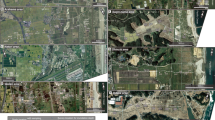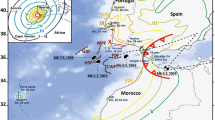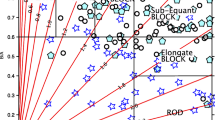Abstract
The 2006 western Java tsunami deposited a discontinuous sheet of sand up to 20 cm thick, flooded coastal southern Java to a depth of at least 8 m and inundated up to 1 km inland. In most places the primarily heavy mineral sand sheet is normally graded, and in some it contains complex internal stratigraphy. Structures within the sand sheet probably record the passage of up to two individual waves, a point noted in eyewitness accounts. We studied the 2006 tsunami deposits in detail along a flow parallel transect about 750 m long, 15 km east of Cilacap. The tsunami deposit first becomes discernable from the underlying sediment 70 m from the shoreline. From 75 to 300 m inland the deposit has been laid down in rice paddies, and maintains a thickness of 10–20 cm. Landward of 300 m the deposit thins dramatically, reaching 1 mm by 450 m inland. From 450 m to the edge of deposition (around 700 m inland) the deposit remains <1 mm thick. Deposition generally attended inundation—along the transect, the tsunami deposited sand to within about 40 m of the inundation limit. The thicker part of the deposit contains primarily sand indistinguishable from that found on the beach 3 weeks after the event, but after about 450 m (and roughly coinciding with the decrease in thickness) the tsunami sediment shifts to become more like the underlying paddy soil than the beach sand. Grain sizes within the deposit tend to fine upward and landward, although overall upward fining takes place in two discrete pulses, with an initial section of inverse grading followed by a section of normal grading. The two inversely graded sections are also density graded, with denser grains at the base, and less dense grains at the top. The two normally graded sections show no trends in density. The inversely graded sections show high density sediment to the base and become less dense upward and represents traction carpet flows at the base of the tsunami. These are suggestive of high shear rates in the flow. Because of the grain sorting in the traction carpet, the landward-fining trends usually seen in tsunami deposits are masked, although lateral changes of mean sediment grain size along the transect do show overall landward fining, with more variation as the deposit tapers off. The deposit is also thicker in the more seaward portions than would be produced by tsunamis lacking traction carpets.






Similar content being viewed by others
References
Asikin, S., Handoyo, A., Prastistho, B., and Gafoer, S., 1992, Geology of the Banyumas Quadrangle, Java: Bandung, Indonesia, Geological Research and Development Center, Department of Mines and Energy.
Bahlburg, H., and Weiss, R., 2007, Sedimentology of the December 26, 2004, Sumatra tsunami deposits in eastern India (Tamil Nadu) and Kenya: International Journal of Earth Sciences, vol. 96, no. 6, p.1195-1209.
Bilek, S.L., and Engdahl, E.R., 2007, Rupture characterization and aftershock relocations for the 1994 and 2006 tsunami earthquakes in the Java subduction zone. Geophys. Res. Lett., 34, L20311, doi:1029/2007GL031357.
Dawson, A.G., Shi, S., Dawson, S., Takahashi, T., and Shuto, N., 1996, Coastal sedimentation associated with the June 2nd and 3rd, 1994 tsunami in Rajegwesi, Java: Quaternary Science Reviews, v. 15, p. 901-912.
Dietrich, W.E., 1982. Settling velocity of natural particles. Water Resources Research 18, 1615–1626.
Dominey-Howes, D., and Thaman, R., 2009, UNESCO-IOC International Tsunami Survey Team Samoa (ITST Samoa) Interim Report of Field Survey, 14th Ð 21st October 2009. Australian Tsunami Research Centre Miscellaneous Report No. 2: October 2009, 190 p.
Fritz, H.M., J.C. Borrero, C.E. Synolakis, J. Yoo, 2006, 2004 Indian Ocean tsunami flow velocity measurements from survivor videos, Geophys. Res. Lett., 33, L24605, doi:10.1029/2006GL026784.
Fritz, H.M., Hager, W.H., Minor, H.-E., 2003, Landslide generated impulse waves: part 1: instantaneous flow fields. Exp. Fluids 35:505-519.
Fritz, H.M., W. Kongko, A. Moore, B. McAdoo, J. Goff, C. Harbitz, B. Uslu, N. Kalligeris, D. Suteja, K. Kalsum, V. Titov, A. Gusman, H. Latief, E. Santoso, S. Sujoko, D. Djulkarnaen, H. Sunendar, C. Synolakis, 2007, Extreme runup from the 17 July 2006 Java tsunami, Geophys. Res. Lett., 34, L12602, doi:10.1029/2007GL029404.
Fujii, Y., and Satake, K., 2006, Source of the July 2006 West Java tsunami estimated from tide gauge records, Geophys. Res. Lett., 33, doi:10.1029/2006GL028049.
Gelfenbaum, G., and Jaffe, B., 2003, Erosion and sedimentation from the 17 July, 1998 Papua New Guinea tsunami: Pure and Applied Geophysics, v. 160, p. 1969-1999.
Jaffe, B., and Gelfenbaum, G., 2007, A Simple Model for Calculating Tsunami Flow Speed from Tsunami Deposits: Sedimentary Geology, v. 200, p. 347-361.
LeRoux, J.P., and Vargas, G., 2005, Hydraulic behavior of tsunami backflows: insights from their modern and ancient deposits: Environmental Geology, v. 49, p. 65-75.
Minoura, K., Imamura, F., Takahashi, T., and Shuto, N., 1997, Sequence of sedimentation processes caused by the 1992 Flores tsunami: Geology, v. 25, p. 523-526.
Moore, A., 1994, Evidence for a Tsunami in Puget Sound ~1000 Years Ago [M.S. thesis]: Seattle, University of Washington.
Moore, A., McAdoo, B.G., and Ruffman, A., 2007, Landward fining from multiple sources in a sand sheet deposited by the 1929 Grand Banks tsunami, Newfoundland: Sedimentary Geology, v. 200, p. 336-346.
Moore, A., Nishimura, Y., Gelfenbaum, G., Kamataki, T., and Triyono, R., 2006, Sedimentary deposits of the 26 December 2004 tsunami on the northwest coast of Aceh, Indonesia: Earth, Planets, and Space, v. 58, p. 253-258.
Newman, A. V., and E. A. Okal, 1998, Teleseismic estimates of radiated seismic energy: The E/M0 discriminant for tsunami earthquakes, J. Geophys. Res., 103(11), 26,885–26,898.
Nishimura, Y., and Miyaji, N., 1995, Tsunami deposits from the 1993 Southwest Hokkaido earthquake and the 1640 Hokkaido Komagatake eruption, Northern Japan, in Satake, K., and Imamura, F., eds., Tsunamis: 1992-1994, their generation, dynamics, and hazard: Basel, Birkhäuser, p. 719-734.
Paris, R., Wassmer, P., Sartohadi, J., Lavigne, F., Barthomeuf, B., Desgages, E., Grancher, D., Baumert, P., Vautier, F., Brunstein, D., and Gomez, C., 2009, Tsunamis as geomorphic crises: Lessons from the December 26, 2004 tsunami in Lhok Nga, West Banda Aceh (Sumatra, Indonesia): Geomorphology, 104, 59-72.
Reymond, D., and E. A. Okal, 2006, Rapid, yet robust source estimates for challenging events: Tsunami earthquakes and mega-thrusts, Eos Trans. AGU, 87(52), Fall Meet. Suppl., Abstract S14A-02.
Sato, H., Shimamoto, T., Tsutsumi, A., and Kawamoto, E., 1995, Onshore tsunami deposits caused by the 1993 Southwest Hokkaido and 1983 Japan Sea earthquakes, in Satake, K., and Imamura, F., eds., Tsunamis: 1992-1994, their generation, dynamics, and hazard: Basel, Birkhauser, p. 693-717.
Shi, S., Dawson, A.G., and Smith, D.E., 1995, Coastal sedimentation associated with the December 12th, 1992 tsunami in Flores, Indonesia, in Satake, K., and Imamura, F., eds., Tsunamis: 1992-1994, their generation, dynamics, and hazard: Basel, Birkhauser, p. 525-536.
Sohn, Y.K., 1997, On traction-carpet sedimentation: Journal of Sedimentary Research, v. 67, p. 502-509.
Author information
Authors and Affiliations
Corresponding author
Rights and permissions
About this article
Cite this article
Moore, A., Goff, J., McAdoo, B.G. et al. Sedimentary Deposits from the 17 July 2006 Western Java Tsunami, Indonesia: Use of Grain Size Analyses to Assess Tsunami Flow Depth, Speed, and Traction Carpet Characteristics. Pure Appl. Geophys. 168, 1951–1961 (2011). https://doi.org/10.1007/s00024-011-0280-8
Received:
Revised:
Accepted:
Published:
Issue Date:
DOI: https://doi.org/10.1007/s00024-011-0280-8




